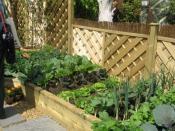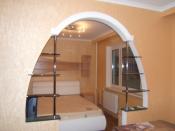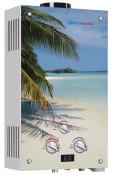Search
Login
Plant lighting, plant artificial lighting, options, useful tips
Photosynthesis is one of the most important processes occurring in plants under the influence of sunlight. Without it, plant nutrition worsens, it begins to starve and slowly wither away. Lack of lighting leads to a weakening of immunity, resistance to diseases and pests is significantly reduced. Since it is not customary to place all the flowers available in the house on window sills today, the problem of lighting for plants located around the entire perimeter of the room is quite acute. Particularly important is the proper organization of backlighting in the winter, when the sun is dim and its light is not enough for normal life of representatives of subtropical vegetation.
Content
- Symptoms of a chronic lack of lighting in indoor plants video
- DNA lamps and their advantages
- General purpose and special fluorescent lamps
- LED illumination of plants and its advantages video
- Lamp for illumination of plants - at what distance from flowerpots should it be
- How to equip a backlight
- Features of decorative illumination of indoor plants
Symptoms of a chronic lack of lighting in indoor plants

It is important for owners of apartments whose interior is decorated with a large number of decorative plants to notice in time that their pets suffer from a lack of light. If plants lack light, then the following can be observed:
- chopping leaves
- change and decrease the brightness of the color,
- change in color of cirrus to monophonic,
- falling of undeveloped buds, wilting of blossoming leaves,
- complete cessation of flowering or a decrease in its intensity.
The most common situation is when the flowers stop giving new shoots, and the old ones gradually dry out. Even those plants that are dormant in winter should not completely discard old leaves.
Rearrange each of the flowerpots on the windowsill is not always possible, so you have to resort to additional lighting. As lighting devices, the most ordinary sconces and chandeliers with incandescent bulbs are used. Unfortunately, such light does not always suit plants, in addition, the heat generated by the lamps damages them. Optimum illumination for indoor plants can be organized using arc sodium lamps, a new generation of DNaT lamps.
DNA lamps and their advantages

DNaT Lucalox PSL, manufactured in Hungary, is intended for use in technological processes of growing plants in greenhouse conditions. High-quality lighting is achieved due to the wide spectrum of radiation such lamps have; they enhance the photosynthesis process by enhancing the absorption of light rays by plants. DNA lamps have a light output of about 10 times greater than conventional incandescent lamps.
Similar parameters are produced by Belgian experts DNAN Silvania lighting device, which provides illumination for plants throughout the entire period of their development. A distinctive feature of Silvania DNaT lamps is the presence of blue in their spectrum and a very high light output.
The presence in the spectrum of the optimal amount of red radiation increases the rate of vegetative development of plants.
General purpose and special fluorescent lamps

These fairly common sources of domestic lighting are more suitable for illuminating plants than incandescent lamps. Their light output is quite high, they practically do not radiate heat, and they have a long service life. The problem is a radiation spectrum that is not quite suitable for plant development. This disadvantage is to some extent compensated by the large amount of light received from them.

Install lamps at a distance of not more than 0.5 m from plants and not less than 0.15 m - this is an indicator for plants very photophilous. The backlight is mounted along the entire shelf on which flower pots or seedlings are located.
The second kind of fluorescent lamps is characterized by a special coating of a glass bulb, bringing the spectrum closer to that which is optimal for plants.
LED illumination of plants and its advantages

Since plants need light with a special composition of the spectrum, when using ordinary bulbs, plants receive light, but not the one that is necessary for their development. It turns out that the funds spent on lighting are used irrationally.

Optimum light composition can be obtained by using LED backlight, which is characterized by light waves of certain values. The benefits of LED backlighting include a lifespan of 50,000 hours. The limiting factor in its distribution is high cost. But at the same time, ice lamps consume less electricity, which reduces their payback period by the year.
The system design can be of any complexity - in case the lamp burns out, it will not be necessary to disassemble the entire structure to replace the element.
If the luminous intensity of standard lighting is measured in Lumens, then the power of the PAR sources is determined in W per square meter, but it is difficult to obtain the exact value. If, during the presentation of PAR-lamps, Lumens are declared as the main parameter, then such advertising should not be particularly trusted.

The best evidence of the effectiveness of LED lighting is to use it to illuminate hydroponic greenhouses in space stations. When creating LED systems, there are certain difficulties - their components must have a strictly defined wavelength in a given range, this requires a laboratory test of each batch produced, in addition, LED strips for plant illumination must have increased light output.
Using systems with different light spectra can have different effects on growth. Shifted towards the violet and blue regions, the spectrum exerts an increased influence on the development of the roots, the activity of flowering and ripening of the fruits, towards red and infrared on the growth of the leaves.

In the circles of researchers today there is a debate about exactly at which blue and red wavelengths the peak of photosynthesis occurs, but in any case it is much easier to obtain the specified parameters using LED strips to illuminate the plants. The use of light filters for traditional sources leads to a strong drop in efficiency.
Among the advantages of LED systems, it should be noted the safety of placing them directly near the leaves, while the loss of light is minimized, one should not be afraid of moisture entering the lamps - the LEDs supply voltage is low. The working temperature of the ice sources is also low - additional watering of plants is not required.
Lamp for illumination of plants - at what distance from flowerpots should it be

The optimal distance at which artificial light sources should be from the plant is 0.3-0.6 m, for flowering pots this distance is reduced to 0.15-0.3 m. However, this figure is very arbitrary - if the light sources are indoors several, and the light from them is quite bright, then there is no point in observing these requirements. But if there are not many lamps, then the flowerpots should be placed closer to the light sources.
If the illumination of the plant is possible only on one side - the pot will have to be periodically rotated around the axis - this will contribute to the uniform formation of the crown.
How to equip a backlight

After arranging the artificial lighting system for plants, it is advisable to carefully observe the plants in it. Perhaps the lighting will be insufficient, then you will need to add one or more lamps, or bring them closer to the plants. The daily need for plant illumination depends on the length of daylight and the brightness of natural light. Usually, lighting is required for a couple of hours in the morning and before sunset, in total - no more than 8 hours.
principles of choice

When choosing fixtures, those that are equipped with a shutter should be avoided - even ordinary glass can interfere with the passage of light, for example, window delays up to 80% of solar radiation. Therefore, lamp bulbs should be made of special grades of glass; one should not forget that they also periodically need to be dusted.
When choosing a place for installing fixtures, one should not forget that the intensity of lighting is directly proportional to the distance from the object to the light source. To obtain the maximum effect from lighting for plants, the illuminated object should be positioned so that the rays fall on it perpendicularly. Since the leaves on the plants are located in a horizontal plane, the light source should be located at the top.
reflectors

A significant increase in the degree of illumination will be facilitated by the installation of a reflector (reflector), and light output can increase by half. The effect is obtained by reflecting the rays going up and to the side of the lamp. Reflectors are usually elliptical or conical in shape, for fluorescent lamps - p-shaped. Ideal reflectors are matte white surfaces, the opinion that the mirror surface reflects better is wrong.
In many lighting devices, the installation of the reflector is carried out initially, in gas-discharge halogen lamps they are contained in the bulb. For a primitive reflector, created by yourself, you can use tin and foil. When making a reflector with your own hands, you must not forget about the safety rules.
timers
If you create a serious home lighting system, it should be supplemented with an electric timer, installing it on the network between the lamp and the outlet. An electronic programmer is more convenient to use, but its cost is slightly higher than that of a mechanical one. The electronic device allows you to:
Automate the on and off of the lamp at a precisely designated time,
set the duration of each inclusion.
The program can be drawn up for a long period, for example, for a week or a month.
The lamp should be selected in accordance with its type and power, which determine the intensity of lighting. An important factor is the color composition of the spectrum, the normal growth of plants can ensure the presence of blue and red components in it. Unlike plants, the human eye is more susceptible to yellow-green radiation. Those. a light bulb bright for our eyes is practically useless for plants.
Features of decorative illumination of indoor plants

Illumination is a method that allows to ensure high-quality growth of plants and create a decorative effect, emphasize the beauty of an individual flower or green composition in the interior.
The option of decorative lighting is selected depending on the appearance of the plant itself, the splendor of its crown, its size. For backlighting can be used:
- incandescent lamps,
- phytoluminescent lamps,
- spotlights,
- lED spotlights.
Changing the position of the light source relative to the plant can contribute to interesting visual effects:
- The location of the light sources over the green composition will emphasize its integrity, but at the same time highlight its most interesting components.
- The illuminating light obtained by installing the lamps on the floor under the plant will emphasize certain fragments of the composition and cast a shadow on the wall located behind the composition.
- The backlight created by the illumination located behind the plant will create an emphasis on its silhouette, and the atmosphere in the room will fill with some mystery. As a rule, such a backlight is used for large colors.

The source of light in decorative lighting can be point sources or spotlights. To determine the optimal distance from them to the plants, an experiment should be performed: place the lamp in a selected place, turn it on and bring your hand to the leaves. If heat is felt from the lamp, it is better to move the light source a little further.





